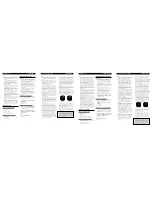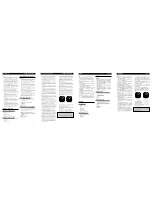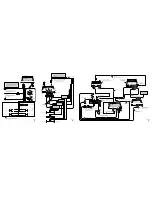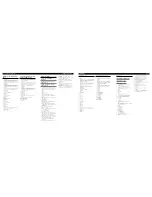
Nota:
•
Antes de finalizar la instalación de la unidad, conecte
el cableado temporariamente, asegurándose de que
todo se encuentra conectado apropiadamente, y la
unidad y el sistema funcionan apropiadamente.
•
Utilice solamente las partes incluídas con la
unidad para asegurar una instalación adecuada.
El uso de partes no autorizadas puede ocasionar
fallas de funcionamiento.
•
Si la instalación requiere del taladrado de orificios u
otras modificaciones del vehículo, consulte con su
agente o concesionario más cercano a su domicilio.
•
Instale la unidad en donde no interfiera con el
conductor y no pueda lesionar al pasajero en caso
de una parada repentina, tal como una frenada de
emergencia.
•
Cuando monte esta unidad, cerciórese que ninguno
de los cables queda aprisionado entre esta unidad y
accesorios o partes metálicas circundantes.
•
No monte esta unidad cerca de la salida del cale-
factor, en donde podría ser afectado por el calor o
cerca de las puertas, en donde la lluvia podría
salpicar sobre la misma.
•
Antes de taladrar cualquier orificio de montaje
siempre compruebe lo que hay detrás en donde
desea taladrar los orificios. No taladre en la línea
de combustible, cableado eléctrico u otras partes
importantes.
•
Si esta unidad es instalada en el compartimiento de
pasajeros, fíjela seguramente de modo que no se
desprenda mientras el automóvil se encuentra en
movimiento, y pueda ocasionar lesiones o accidentes.
•
Si esta unidad se instale bajo un asiento delantero,
cerciórese de que no obstruye el movimiento del
asiento. Pase todos los cables y conductores cuida-
dosamente a través de los mecanismo deslizantes,
de modo que no queden aprisionados o atrapados en
el mecanismo y ocasionen un corto circuito.
Instalación de la unidad
Montaje con ménsulas (Fig. 1)
1. Tornillo autoterrajante (4
×
12 mm)
2. Tornillo (4
×
8 mm)
3. Ménsula
4. Evite cerrar este área.
5. Alfombra del automóvil o chasis
6. Taladre orificios de 2 a 2,5 mm de diámetro.
Montaje con cinta adherente (Fig. 2)
Limpie completamente la superficie antes de fijar
la cinta adherente o Velcro.
7. Cinta adherente (Velcro)
8. Alfombra del automóvil o chasis
Encaminamiento del cable óptico
Precaución:
•
Intente no doblar mucho el cable óptico. Si es
necesario doblar el cable, asegúrese de que el
radio de curvatura es de por lo menos 25 mm, de
lo contrario el cable no transferirá las señales
apropiadamente y, por lo tanto, la unidad no fun-
cionará correctamente.
•
Encamine el cable óptico de modo que nada peso
quede sobre el cable, y de modo que no pueda
ser pisado o agarrado en algo - por ejemplo, una
puerta.
•
Haga un bucle con un diámetro de por lo menos
200 mm con el cable óptico restante de modo
que el cable no se deforme.
•
Al conectar el cable óptico a la unidad, utilice la
abrazadera de cable suministrada para prevenir
que el cable se doble excesivamente.
•
Encamine el cable óptico de modo que no se
agarre en las piezas móviles tales como el cam-
bio de engranajes, freno de mano, o mecanismo
de deslice de los asientos. Mantenga el cables
alejado de puntos calientes, tales como cerca de
la salida del calentador.
Uso del tubo ondulado (Fig. 3)
Para prevenir que el cable óptico se deforme,
utilice el tubo ondulado después de cortarlo al
largo correcto.
• Inserte el cable óptico en el tubo
ondulado.
9. Cable óptico
10. Tubo ondulado
Montaje de la abrazadera (Fig. 4) (Fig. 5)
La abrazadera se usa para asegurar el cable ópti-
co cuando se lo usa. La otra abrazadera está
instalada de manera similar en el lado posterior
de la unidad principal, y se usa para asegurar el
cable óptico.
1. Inserte la abrazadera en la dirección
indicada en la figura, y gírela en 90
grados para asegurarla.
11. Abrazadera
2. Asegure el cable óptico.
12. Cable óptico
Instalación
<ESPAÑOL>
Conexión de las unidades
<ESPAÑOL>
Nota:
•
Esta unidad es para vehículos con batería de 12
voltios y con conexión a tierra. Antes de instalar la
unidad en un vehículo recreativo, camioneta, o
autobús, revise el voltaje de la batería.
•
Para evitar cortocircuitos en el sistema eléctrico,
asegúrese de desconectar el cable de la batería
≠
antes de comenzar con la instalación.
•
Consulte con el manual del usuario para los
detalles sobre la conexión de la alimentación de
amperios y de otras unidades, luego haga las
conexiones correctamente.
•
Asegure el cableado con abrazaderas de cables o
con cinta adhesiva. Para proteger el cableado,
envuélvalo con cinta adhesiva donde éstos se apoy-
an sobre las piezas de metal.
•
Coloque y asegure todo el cableado de tal manera
que no toque las piezas en movimiento, tal como la
palanca de cambio de velocidades, el freno de
mano, y los pasamanos de los asientos. No coloque
el cableado en lugares que se calientan, tal como
cerca de la salida de un calefactor. Si el material
aislante del cableado se derritiera o se gastara,
habrá el peligro de un cortocircuito del cableado a
la carrocería del vehículo.
•
No pase el conductor amarillo a través de un orifi-
cio en el compartimiento del motor para conectar a
la batería. Esto dañará el material aislante del con-
ductor y causará un cortocircuito peligroso.
•
No acorte ningún conductor. Si lo hiciera, la pro-
tección del circuito podría fallar al funcionar cuan-
do debería.
•
Nunca alimente energía a otros equipos cortando el
aislamiento del conductor de alimentación provista
de la unidad y haciendo un empalme con el con-
ductor. La capacidad de corriente del conductor se
excederá, causando el recalentamiento.
•
Cuando reemplace algún fusible, asegúrese de
utilizar solamente un fusible del ratio descrito en
el soporte de fusibles.
•
Ya que se emplea un circuito único BPTL, nunca
coloque los cables de manera que los conductores
del altavoz estén directamente en conexión a tierra
o que el altavoz izquierdo y derecho
≠
sean
comunes.
•
Los altavoces conectados a esta unidad deberán ser
del tipo de alta potencia, teniendo un régimen mín-
imo de 50 W y una impedancia de 4 a 8 ohmios.
La conexión de altavoces con valores de impedan-
cia y/o de salida diferentes a los anotados aquí
podrían causar fuego, emisión de humo o daños a
los altavoces.
•
Cuando se conecta la fuente de este producto, una
señal de control se emite a través del conductor
azul/blanco. Conecte al control remoto de sistema
de un amplificador de potencia externo o al terminal
de controle de relé de antena automática del vehícu-
lo (máx. 300 mA 12 V CC). Si el vehículo tiene una
antena en vidrio, conecte al terminal de suministro
de energía de la antena.
•
Cuando se está utilizando un amperio de potencia
externa con este sistema, asegúrese de no conectar
el conductor azul/blanco al terminal de potencia
de amperios. Asimismo, no conecte el conductor
azul/blanco al terminal de potencia de la auto-
antena. Tal conexión podría causar la fuga de cor-
riente excesiva y causar fallos de funcionamiento.
•
Para evitar cortocircuitos, cubra el conductor
desconectado con cinta aislada. Especialmente, aísle
los conductores de altavoz no usados. Hay la posibil-
idad de cortocircuito si no se aíslan los conductores.
•
Para evitar la conexión incorrecta, el lado de entra-
da del conector IP-BUS o del conector del cable
óptico es azul, y el lado de salida es negro. Conecte
los conectores del mismo color correctamente.
•
Si se instala esta unidad en un vehículo que no tiene
una posición ACC (accesorio) en el interruptor de
encendido, el conductor rojo de la unidad deberá
conectarse al terminal conectado con las operaciones
del interruptor de encendido ON/OFF. Si no se hace
esto, la batería del vehículo podría drenarse cuando
usted esté lejos del vehículo por varias horas.
•
El conductor negro es la masa. Conecte a masa
este conductor separadamente desde la masa de
los productos de alta corriente tal como los
amplificadores de potencia.
Si conecta juntos a masa los productos y la masa
se desconecta, se crea el riesgo de daños a los
productos o de incendios.
•
Para asegurar una disipación de calor apropiada
de este producto, tenga especial precaución de no
bloquear el lado del ventilador de enfriamiento
de este producto.
No en la posición ACC
Posición ACC
ON
S
T
A
R
T
O
FF
ACC
ON
S
T
A
R
T
O
FF
•
Los cables para este producto y aquéllas para
otros productos pueden ser de colores diferentes
aun si tienen la misma función. Cuando se
conecta este producto a otro, refiérase a los
manuales de ambos productos y conecte los
cables que tienen la misma función.
Note:
•
This unit is for vehicles with a 12-volt battery
and negative grounding. Before installing it in a
recreational vehicle, truck, or bus, check the bat-
tery voltage.
•
To avoid shorts in the electrical system, be sure
to disconnect the
·
battery cable before begin-
ning installation.
•
Refer to the owner’s manual for details on con-
necting the power amp and other units, then
make connections correctly.
•
Secure the wiring with cable clamps or adhesive
tape. To protect the wiring, wrap adhesive tape
around them where they lie against metal parts.
•
Route and secure all wiring so it cannot touch
any moving parts, such as the gear shift, hand-
brake and seat rails. Do not route wiring in
places that get hot, such as near the heater outlet.
If the insulation of the wiring melts or gets torn,
there is a danger of the wiring short-circuiting to
the vehicle body.
•
Don’t pass the yellow lead through a hole into
the engine compartment to connect to the battery.
This will damage the lead insulation and cause a
very dangerous short.
•
Do not shorten any leads. If you do, the protec-
tion circuit may fail to work when it should.
•
Never feed power to other equipment by cutting
the insulation of the power supply lead of the
unit and tapping into the lead. The current capac-
ity of the lead will be exceeded, causing over-
heating.
•
When replacing fuse, be sure to use only fuse of
the rating prescribed on the fuse holder.
•
Since a unique BPTL circuit is employed, never
wire so the speaker leads are directly grounded or
the left and right
·
speaker leads are common.
•
Speakers connected to this unit must be high-
power types with minimum rating of 50 W and
impedance of 4 to 8 ohms. Connecting speakers
with output and/or impedance values other than
those noted here may result in the speakers catch-
ing fire, emitting smoke or becoming damaged.
•
When this product’s source is switched ON, a
control signal is output through the blue/white
lead. Connect to an external power amp’s system
remote control or the car’s Auto-antenna relay
control terminal (max. 300 mA 12 V DC). If the
car features a glass antenna, connect to the anten-
na booster power supply terminal.
•
When an external power amp is being used with
this system, be sure not to connect the blue/white
lead to the amp’s power terminal. Likewise, do
not connect the blue/white lead to the power ter-
minal of the auto-antenna. Such connection could
cause excessive current drain and malfunction.
•
To avoid short-circuiting, cover the disconnected
lead with insulating tape. Especially, insulate the
unused speaker leads without fail. There is a pos-
sibility of short-circuiting if the leads are not
insulated.
•
To prevent incorrect connection, the input side of
the IP-BUS or optical cable connector is blue,
and the output side is black. Connect the connec-
tors of the same colors correctly.
•
If this unit is installed in a vehicle that does not
have an ACC (accessory) position on the ignition
switch, the red lead of the unit should be con-
nected to a terminal coupled with ignition switch
ON/OFF operations. If this is not done, the vehi-
cle battery may be drained when you are away
from the vehicle for several hours.
•
The black lead is ground. Please ground this lead
separately from the ground of high-current prod-
ucts such as power amps.
If you ground the products together and the
ground becomes detached, there is a risk of dam-
age to the products or fire.
•
To ensure proper heat dissipation of this product,
take special care not to block the cooling fan side
of this product.
No ACC position
ACC position
ON
S
T
A
R
T
O
FF
ACC
ON
S
T
A
R
T
O
FF
Note:
•
Before finally installing the unit, connect the
wiring temporarily, making sure it is all connect-
ed up properly, and the unit and the system work
properly.
•
Use only the parts included with the unit to
ensure proper installation. The use of unautho-
rized parts can cause malfunctions.
•
Consult with your nearest dealer if installation
requires the drilling of holes or other modifica-
tions of the vehicle.
•
Install the unit where it does not get in the dri-
ver’s way and cannot injure the passenger if there
is a sudden stop, like an emergency stop.
•
When mounting this unit, make sure none of the
leads are trapped between this unit and the sur-
rounding metalwork or fittings.
•
Do not mount this unit near the heater outlet,
where it would be affected by heat, or near the
doors, where rainwater might splash onto it.
•
Before drilling any mounting holes always check
behind where you want to drill the holes. Do not
drill into the gas line, brake line, electrical wiring
or other important parts.
•
If this unit is installed in the passenger compart-
ment, anchor it securely so it does not break free
while the car is moving, and cause injury or an
accident.
•
If this unit is installed under a front seat, make
sure it does not obstruct seat movement. Route
all leads and cords carefully around the sliding
mechanism so they do not get caught or pinched
in the mechanism and cause a short circuit.
Installing the unit
Mounting with brackets (Fig. 1)
1. Tapping screw (4
×
12 mm)
2. Screw (4
×
8 mm)
3. Bracket
4. Do not close this area.
5. Car mat or chassis
6. Drill 2 to 2.5 mm diameter holes.
Mounting with velcro tape (Fig. 2)
Thoroughly wipe off the surface before affixing
the velcro tape.
7. Velcro tape
8. Car mat or chassis
Routing the optical cable
Precaution:
•
Try not to bend the optical cable sharply. If it is
necessary to bend it sharply, make sure that the
bending radius is at least 25 mm, otherwise the
cable will not transfer signals properly and so
this unit will not work properly.
•
Route the optical cable so that nothing heavy
rests on it, and so that it cannot be stepped on or
caught in anything – for instance, a door.
•
Make a loop of diameter at least 200 mm with
the remaining optical cable so that the cable does
not get strained.
•
When plugging the optical cable into the unit,
use the supplied cable clamps to prevent the
cable from being bent sharply.
•
Route the optical cable so that it does not get
caught in moving parts such as the gear shift,
hand brake, or seat sliding mechanism. Keep the
cable away from hot spots, such as near the
heater outlet.
Using the corrugated tube (Fig. 3)
To prevent the optical cable from being strained,
use the corrugated tube after cutting it to the cor-
rect length.
• Insert the optical cable into the cor-
rugated tube.
9. Optical cable
10. Corrugated tube
Mounting the clamp (Fig. 4) (Fig. 5)
The clamp is used to secure the optical cable
when using it. The other clamp is installed on the
back side of the head unit similarly and used to
secure the optical cable.
1. Insert the clamp in the direction
indicated in the figure, and turn it 90
degrees to lock.
11. Clamp
2. Secure the optical cable.
12. Optical cable
Installation
<ENGLISH>
Connecting the Units
<ENGLISH>
•
Cords for this product and those for other prod-
ucts may be different colors even if they have
the same function. When connecting this prod-
uct to another product, refer to the supplied
manuals of both products and connect cords that
have the same function.

























